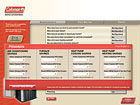
Coleman’s In Home Selling Tool now projects savings based on more accurate, local information.
Are they programs or are they apps? Sometimes calling them the wrong thing conjures up images of floppy disks and cavemen. To be on the safe side, let’s just call them tools.
How have they been developing to meet specific needs within this industry? According to Brad Mathews, vice president of marketing, Dexter + Chaney, “The trend is that software development has truly focused on the service process.”
One of the major goals of management software for this industry “is to make service operations flow smoothly, to save time and effort all along the primary company process of receiving customer requests and providing the needed service,” he said, “all in a way that satisfies customers and provides for a healthy profit.”
He broke the goal down into smaller steps with three key players in this workflow: the customer, the dispatcher, and the service technician. “Each is vital to the process,” Mathews said. “Their inter-related problems are the challenge that has driven recent software development.”
Today individual products can create an even workflow. “We begin with the customer’s initial contact,” which comes via phone or e-mail. E-mail service requests can be dragged from the dispatcher’s e-mail and dropped onto a service request.
It also can search for the customer’s record or indicate that it’s a new customer and create a work order. The software generates an e-mail response to the customer. It can also use phone information to provide info for the call.
The service tech’s schedule is instantly updated with the new appointment. The tech in the field can be equipped with mobile internet access so he can view his updated schedule, the work requested, and details on the customer’s site. The tech can update his arrival and departure status for the dispatcher, and can send the customer a paperless invoice.
CONSOLIDATION
Karl Koenig, president of Penta Technologies Inc., said the big trends he’s noticed are those that help build long-term customer relationships with an emphasis on service work, which can become a stepping stone to more work.Service and new construction “may not have the same view of the customer,” Koenig said. Estimating and design also were separate. Staff and systems were separate. It all created inefficiencies and lost opportunities. “They needed one system that would do new construction and service very well in one shared view,” he said.
Contractors also need business analytics to deal with the information intelligently, expose data to customers to give more value, let customers initiate action, and control content. “We’ve combined a true enterprise content management that can store and manage any content within your company, and get attached to your change order, for example.” It can deal with content, transactions, and get combined with the workflow and mobile information, Koenig said. “That was the secret sauce. You significantly reduce the spread out information. You can see everything.”
Enterprise content management provides a way to route, track, combine, and create paperless job folders.
Koenig said contractors using the products are “deep into management and execution. The service system sends calls and tracking to the mobile device and boom, it goes right to accounting. With all that info available, it can increase efficiency.” The company also built out maintenance agreement capabilities, tracking for customer equipment, and parts. “Contractors can do a better job of estimating and tracking costs.”
It also provides the ability to determine between over maintenance and repairing on demand. “It allows you to become more tightly aligned with your customer.”
SALES TOOLS
Some new systems offer contractors more insight into savings. For instance, Coleman made changes to its In Home Selling Tool, to equip dealers with information, so they can provide homeowners with a better estimate of the savings associated with new equipment.Introduced to dealers in 2008, the interactive program was designed to help them prescribe solutions to best fit the needs of their customers. An interactive questionnaire (run from a dealer’s laptop) gathers information about the house, the existing HVAC system, and homeowner needs. It also projects savings based on more accurate, local information. According to Natalie DeRousse, sales and UST training manager, “The result is a more accurate estimate of savings, tailored to the region.”
Changes also include updated product information and two new videos - one on the federal tax credit and a second that focuses on hybrid systems. They are geared toward the homeowner.
“Dealers who make use of the questions, videos, and savings calculator have the opportunity to more actively engage homeowners in the purchase process,” said Mary Mocarski, Coleman HVAC brand manager for Johnson Controls. “Homeowners who take the time to complete the questionnaire, view the videos, and discuss the results of the savings calculator will gain a sense of ownership in the purchase process.”
Another product, ACquotePro (see the feature article “Web-Based Program Offers Contractors Customization and Standardization” in this issue), provides a real-time, web-based selling tool that is said to allow contractors to quickly create customized proposals for every job, no matter their size. It can provide real-time proposals, database tracking, and dashboard reporting for sales management. It improves information transfer during circumstances like change orders, as well as automatic customer follow-up for all open accounts.
Publication date:12/27/2010



